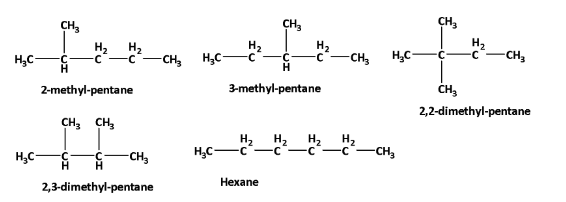
Answer
107.4k+ views
Hint: The molecular formula is a way to write a substance using the chemical symbol and number subscripts to mention the number of the atoms into that chemical compound. On the other hand, a condensed formula is basically like the structural formula but here it is showing that all groups are attached with one single atom.
Complete step by step answer:
There are some compounds which have the same molecular formula but a different arrangement of atoms with different properties are known as isomers to each other.
There are different kinds of isomers. They are,
Constitutional isomers: which compounds are the same in the molecular formula but bonds are different in between the atoms is called constitutional isomers.
Stereoisomers: which compounds are the same in the molecular formula; bonds are the same in between the atoms but the relative positions of the groups are different; those compounds are called Stereoisomers.
In case \[{C_6}{H_{14}}\] there are a total of five constitutional isomers present but no stereoisomers are present.
Now the molecular formula of those isomers of hexane is \[{C_6}{H_{14}}\] . But the condensed isomers are different in each isomer, this is because the bonds between the atoms of the molecule are different in the isomers of hexane.
The structural formula of all five isomers of hexane with six C-atoms \[({C_6}{H_{14}})\] is,
2-methyl-pentane \[(C{H_3}CH(C{H_3})C{H_2}C{H_2}C{H_3})\] , 3-methyl-pentane \[(C{H_3}C{H_2}CH(C{H_3})C{H_2}C{H_3})\] , 2,2-dimethyl-butane \[(C{H_3}C{(C{H_3})_2}C{H_2}C{H_3})\] , 2,3-dimethyl-butane \[(C{H_3}CH(C{H_3})CH(C{H_3})C{H_3})\] , hexane\[(C{H_3}C{H_2}C{H_2}C{H_2}C{H_2}C{H_3})\] .
Structures are,

Note:
The empirical formula of any compound gives the lowest value of the ratio of the elements present in a molecule. But from this formula the actual number of the elements present in the molecule cannot be defined. . The molecular formula of a compound is with the actual number of the elements present in a compound. The relation between them is given by,\[{\text{ }}molecular{\text{ }}formula = {\left( {{\text{ }}emperical{\text{ }}formula} \right)_n}\].
Complete step by step answer:
There are some compounds which have the same molecular formula but a different arrangement of atoms with different properties are known as isomers to each other.
There are different kinds of isomers. They are,
Constitutional isomers: which compounds are the same in the molecular formula but bonds are different in between the atoms is called constitutional isomers.
Stereoisomers: which compounds are the same in the molecular formula; bonds are the same in between the atoms but the relative positions of the groups are different; those compounds are called Stereoisomers.
In case \[{C_6}{H_{14}}\] there are a total of five constitutional isomers present but no stereoisomers are present.
Now the molecular formula of those isomers of hexane is \[{C_6}{H_{14}}\] . But the condensed isomers are different in each isomer, this is because the bonds between the atoms of the molecule are different in the isomers of hexane.
The structural formula of all five isomers of hexane with six C-atoms \[({C_6}{H_{14}})\] is,
2-methyl-pentane \[(C{H_3}CH(C{H_3})C{H_2}C{H_2}C{H_3})\] , 3-methyl-pentane \[(C{H_3}C{H_2}CH(C{H_3})C{H_2}C{H_3})\] , 2,2-dimethyl-butane \[(C{H_3}C{(C{H_3})_2}C{H_2}C{H_3})\] , 2,3-dimethyl-butane \[(C{H_3}CH(C{H_3})CH(C{H_3})C{H_3})\] , hexane\[(C{H_3}C{H_2}C{H_2}C{H_2}C{H_2}C{H_3})\] .
Structures are,

Note:
The empirical formula of any compound gives the lowest value of the ratio of the elements present in a molecule. But from this formula the actual number of the elements present in the molecule cannot be defined. . The molecular formula of a compound is with the actual number of the elements present in a compound. The relation between them is given by,\[{\text{ }}molecular{\text{ }}formula = {\left( {{\text{ }}emperical{\text{ }}formula} \right)_n}\].
Recently Updated Pages
Write a composition in approximately 450 500 words class 10 english JEE_Main

Arrange the sentences P Q R between S1 and S5 such class 10 english JEE_Main

Write an article on the need and importance of sports class 10 english JEE_Main

Name the scale on which the destructive energy of an class 11 physics JEE_Main

Choose the exact meaning of the given idiomphrase The class 9 english JEE_Main

Choose the one which best expresses the meaning of class 9 english JEE_Main




